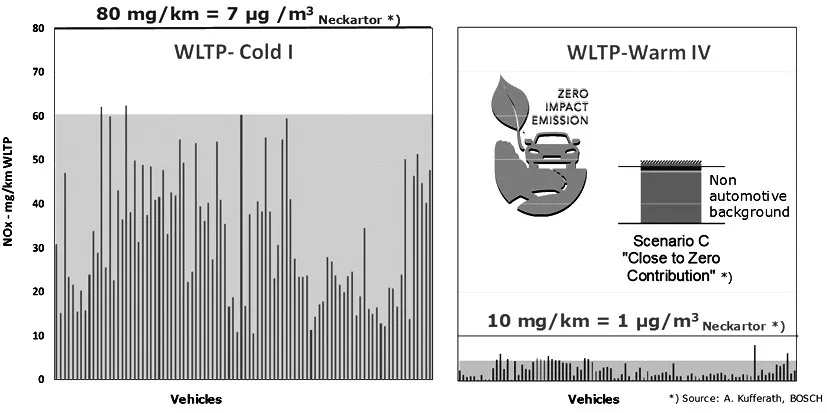最高效和超低排放
——内燃机4.0 Highest Efficiency and Ultra Low Emission–Internal Combustion Engine 4.0
G.Fraidl,P.Kapus,
K.Prevedel,M.Neubauer,M.Certic,T.Schicker AVL List GmbH
Combustion engine and electrification often complement each other in a synergetic way.A fully networked combustion engine designed to meet future needs can be called“Internal Combustion Engine 4.0(ICE 4.0)”.

Fig.1:Emission behavior of EU6dtempvehicles with Gasoline engines
A new generation of ICE’s
Ifone compares the requirements to future powertrains with the definition of Industry4.0 in Germany,then surprising matches are found.
Thus,it is perfectly opportune to call an ICE designed comprehensively for future needs as“Internal Combustion Engine 4.0”.
Zero Impact Emission
“Zero Impact Emission”means that emissions are so low that they have no impact on air quality.
On a Gasoline engine a strong concentration of pollutant emissions on the non-warmed up or highly dynamic engine operation is seen.These relations are not only valid for a single vehicle,but are also confirmed on a broad statistical basis,Fig.1.
In warmed up condition a NOx emission level of only 2–5 mg/km is observed.If a model simulation of critical immission measurement points for Germany–e.g.the Neckartor in Stuttgart–is done then the vehicle emissions only contribute by 0.2-0.5 μg/m3.This is uncritical compared to the legal limit(40 μg/m3)as well as compared to the emissions of the non-automotive sector(approx.18 μg/m3).So for warm engine EU6dtempvehicles could already be called „Zero Impact Emission“[1,2].
Starting from the EU6dtempstatus,the main challenge for further emission reductions are the improvement of pollutant emissions at ICE start and in non-warmed up operating range,as well as the temperature management of the exhaust gas aftertreatment.In addition,various measures to limit pollutant emissions are required in the upper load range.
Electrification of the ICE
Balancing of the properties of electrification and ICE results in a synergetic potential for improvement of pollutant-and CO2emissions.Thus,in future the ICE will change"from a lone fighter to a team player"[3].
Even a mild hybridization can allow to limit the operating range of the ICE and to focus on emission and fuel consumption-favorable areas,Fig.2.
An automated transmission with a large spread helps to operate the ICE in most of the driving situations with bestspecific fuelconsumption ("SweetSpot Follower"-yellow area in Fig.2).With hybridization the load point of the ICE can be shifted towards a highefficiency range by charging of the battery.In the case of sufficient battery charge the vehicle can be driven electrically(lower green area in Fig.2)
In the upper load range the electric torque can be added to the maximum ICE torque(dashed green line).For lowest emissions and best fuel consumption the better approach is to limit the ICE torque and support with electric torque already on a lower absolute torque level especially at low engine speeds(upper green area in Fig.2).This avoids operating ranges with unfavorable performance of the ICE and results in additional synergy effects e.g.a modified design of the turbocharger better matched to the higher flow range(expansion of the stoichiometric operating range).In view of the expected changes in RDE legislation,such a"dynamic limitation"of the ICE also gains additional importance for a robust RDE calibration.However,the electric torque is only temporary,according to the electric energy available,which mustbe considered in the system design accordingly.

Fig.2:Interaction of ICE,Automated Transmission and Mild Hybridization(48V)
Technology approaches Gasoline engine
The currenttechnicalmainstream of Gasoline engines-extended expansion by Miller/Atkinson cycle concepts-will continue in the foreseeable future,but will be further optimized by improved charging systems.In addition to this a certain amount of technology diversification will remain.Variable compression ratio,spark initiated HCCI,advanced ignition and Ultra High Pressure Injection(UHPI)are additional focus points,Fig.3.
Once knock can be limited or eliminated isolation of the combustion chamber(“adiabatic engine“)can shift energy from the low temperature to the high temperature level.In combined processes these additional energy amounts can be used.Peak efficiency levels of 45%up to 50%can be expected in the future[3].
Future emission requirements such as lowest particulate emissions or stoichiometric operation in the complete engine map require advanced emission concepts beyond the three-way catalyst and the particle filter.
By using an electrically heated catalystwith extended preheating/ post heating functionality(“conversion management”)as well as by hybridization and connectivity further significant emission reduction up to“Zero Impact Emission”level is possible even for not fully warmed up engines.

Fig.3:Technology roadmap Gasoline engine
One possibility for improving the knocking behavior and the charge dilution tolerance is a pre-chamber spark plug,left side in Fig.4.
By appropriate alignment of the ignition jets,the combustion can be specifically accelerated in the direction of knock-critical areas and thus the knocking behavior can be improved.An advancement of 50%mass fraction burnt point of up to 8°CrA was achieved[3,4].

Fig.4:Pre-chamber ignition at 2000 rpm;UHPI vs 350 bar injection pressure
The most efficient measure to prevent pre-ignition and knocking is the introduction of the fuel only at the end of the compression immediately before ignition,right side in Fig.4.The local residence time of the fuel in knock-critical areas is too low to trigger pre-ignition or knock=>practically"knock-free"Gasoline engine.
However,the very late introduction and the necessary preparation and distribution ofthe fuel requires extremely high injection pressures.With injection pressures>800 bar and an adequate system design,a sufficientmixture formation quality and homogenization can be achieved even at very late injection.
Conclusions
The uncertainty of the future markets'reaction calls for the development of modular structures of ICE's,transmissions and electrification components.
In the long term,new potentials of the ICE can be seen for pollutant and CO2emissions.In particular,synergy effects with electrification and the networking of powertrain control with all vehicle-relevant traffic and environmental information-“Internal Combustion Engine 4.0”-enables both further fuel consumption improvements and an emission behavior that can be described as"Zero Impact Emission".New combustion concepts will lead to a practically“knock-free”Gasoline engine enabling significantfurtherimprovementof efficiency.
Literature
[1]Fraidl,G.;Kapus,P.;Mitterecker,H.;Prevedel,K.;Teuschl,G.;Weissbäck,M.:Internal Combustion Engine 4.0.39.International Vienna Motorsymposium,Vienna,2018.
[2]Kufferath,A.;Krüger,M.;Naber,D.;Mailänder,E.;Maier,R.:The Path to a Negligible NO2 Immission Contribution from theDieselPowertrain.39.InternationalVienna Motorsymposium,Vienna,2018.
[3]Fraidl,G.;Kapus,P.;Mitterecker,H.;Weissbäck,M.:Internal Combustion Engine 4.0.MTZ 09/2018.
[4]Neubauer,M.;Kapus,P.;Fraidl,G.;Wolf,Ch.;Hilbert,D.;Prevedel,K.;Krenn,M.:Lambda 1 Operation For High Performance Engines.Institution of Mechanical Engineers,Coventry,2018.

